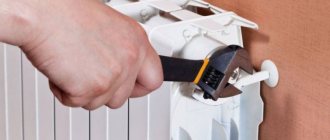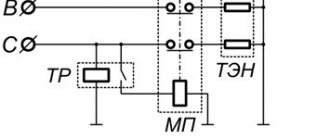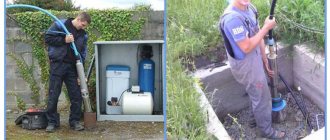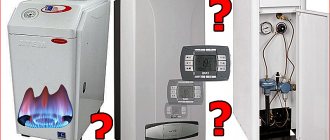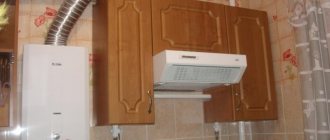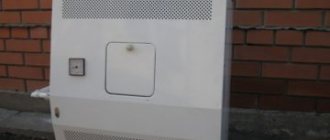Scheduled repairs
Do you want to clean your radiator? Exchange for a newer model or, conversely, install cast iron batteries instead of aluminum (because, in your opinion, they are better)?
If you live in a private house, there are no problems. Just don’t forget that it’s better to fill the system right away and make sure that nothing is leaking anywhere.
If you live in an apartment and you have the opportunity to disconnect from the riser and change the battery yourself, do it. If not, it is better for you to contact the organization that services the heating network of your home so that its employees will shut off the heating system and release water from it centrally.
Material on the topic - how to change the battery (detailed step-by-step instructions are provided).
Do I need to shut off the radiators while cleaning the system?
To ensure radiators have a long service life, when flushing the system by the management company, a number of conditions must be observed. These include:
- New batteries should be covered for the first 2 years after installation, as they are still quite clean. In this case, washing can only clog them. It will be possible to open the shut-off valves a couple of days after the completion of the work, after all the precipitation has gone away.
- Flush radiators yourself at least once every 2 years. This should be done with running hot water.
Instructions for cleaning batteries yourself:
- cover the bathtub with oilcloth;
- put a thick cloth on top;
- close all shut-off valves;
- remove the radiator;
- remove all gaskets;
- rinse the battery with a strong stream of hot water (you can use a shower hose);
- install the radiator, not forgetting to return all gaskets to their place.
Who should do this?
The management company is responsible for the serviceability of communication networks in apartment buildings. The drainage of the heating riser must be agreed upon with them. And most often, invite their own specialists. Hence the questions and ambiguities:
1. Can I choose my own date?
Almost impossible. The management company itself determines the day and time. You can ask to drain the water from the system within a certain time frame only through great connections.
2. At whose expense is the heating riser drained?
Only at the expense of the tenants. They will ask for money both for the approval procedure and for the participation of specialists. Tariffs in different regions and in different companies vary greatly. It is impossible to predict the amount. In one town they will ask for a thousand, and in another - five. The price includes turning off the system, draining the coolant and then filling the network.
If repairs need to be done at the height of the heating season, you will have to convince the management company of the dire need and pay many times more. If it’s below thirty degrees outside, no one will turn anything off. The only exceptions will be emergency situations.
Draining the coolant in the apartment correctly
You should only interfere with the operation of the heating system if such actions are necessary for the normal operation of communications, prevention or elimination of breakdowns. For example, it is impossible to replace a radiator in a room without first draining the liquids. In addition, it is necessary to remove liquid from the pipes when leaks occur, the system is contaminated, and, if necessary, replace the coolant with a new one.
It is important to understand why you are draining the liquid.
In an autonomous home heating system, it is easiest to drain the coolant. To carry out such work, no special permits or approvals are required, since even the occurrence of unforeseen situations in this case cannot cause significant harm to people. To replace the coolant, we perform the following work:
- turn off the heating boiler;
- wait until the water in the system cools completely;
- close the cold water supply valve to the system;
- We open special air valves, which are necessarily present in closed communications.
Modern heating networks have drain valves that are located at the lowest point of the system - usually on the return pipeline in close proximity to the boiler. After completing the operations described above, connect a hose to this tap through which water can be drained from the circuit. When there is no coolant left in the heating network, you can begin to repair the communication, replace its damaged elements, or any other work for which the drain was performed.
One of the main reasons for draining coolant is the need to repair or replace batteries
It is more difficult to properly drain water from the pipes and batteries of an autonomous system if a “warm floor” is installed in the house. In this case, to remove the coolant, you will have to connect a compressor to the inlet pipe of the network, which will help displace water from the pipes using air pressure. Although it is not always necessary to completely drain the water from the system. For example, if you need to replace only one heating battery in a house, you can drain the coolant only from it, of course, if the design of the system and the features of its installation allow this.
It is highly desirable to provide for the possibility of draining water from a specific radiator by installing valves and taps.
To ensure that when following the described recommendations, replacing the coolant does not cause major problems, it is necessary to prepare a container of suitable size in advance. It should contain all the liquid from the autonomous heating supply without any residue. In some cases, you can simply use a long hose that is pulled from the heating drain tap to the street. However, the longer the hose and the older it is, the higher the likelihood of leaks occurring during heating network repairs.
Draining coolant from a heating system located in an apartment building is much more difficult. If you need to remove water from a communication in order to modernize it, you will have to empty the entire riser pipe running through all apartments located in the same vertical from the coolant. Such repairs require prior approval from the company that services the heat supply of the apartment building.
The service of draining water from the riser is paid, it is performed by employees of the responsible company, its cost depends on the time of repair. The most expensive drainage is in the winter during the heating season, and the cheapest in the summer. Therefore, you should plan in advance for the modernization and maintenance of heating elements.
We solve problems with the heating network
Problems with utilities occur quite often, but to repair the heating supply it is not at all necessary to always remove the coolant from the pipes. The most common heating problems include:
- air entering the system circuit;
- pollution;
- insufficient diameter of system pipes;
- low circulation pump power;
- lack of check valves in complex networks;
- making various errors during installation work.
Problems in the heating network are often related to each other. For example, the gurgling of water in pipes can be caused by air getting into the pipes, poor sealing of connections, or the presence of leaks. In order for the system to provide the apartment with the necessary amount of thermal energy and not cause discomfort to users, it must be constantly checked. Monitor the quality of the connection, bleed the air through the Mayevsky taps, and if you find a problem on your own and cannot get rid of it, turn to professionals for help.
Calling specialists in a timely manner when detecting the slightest signs of problems in the heating operation will allow you to avoid serious malfunctions, to eliminate which you will have to spend your money and time, obtain permission to drain water from the riser and coordinate your work with the responsible authorities.
System design features
The design of the heating system in an apartment building is of two types: two-pipe and single-pipe. The single-pipe system has the main disadvantage of cooling the water on its way to the upper floors. Heat is directed from the bottom up under pressure, bypasses all thermal circuits and flows back through the same pipe.
In a two-pipe heating system, the coolant returns back through the second pipe, and the temperature is maintained high as it enters the system throughout its entire route.
Heating systems are also divided into open and closed. In an open system, water comes directly from the heating plant and is distributed through heating and hot water pipes. Most apartment buildings are built according to this type.
In a closed system, water flows only for heating purposes. From the heating plant, water is distributed to heating points, where it is brought to the required temperature before being supplied to residents. A closed autonomous system is also installed in private homes. Installation of an autonomous closed heating system is carried out with the expectation that any part of it can be turned off and the water drained without damaging the remaining part. To do this, ball shut-off valves are installed at the inlet and outlet of radiators. A spare pipe - bypass - is installed. Taps allow you to shut off the coolant supply.
In order for the heating system inside the apartment to be serviced without problems, it must be installed in a certain way. The batteries are placed on a slope so that the water drains quickly.
To drain water from the heating system, the battery must be mounted in a certain way
The batteries must be equipped with shut-off valves, a Mayevsky tap and a tap for draining water. Old cast iron batteries in most cases do not have any fittings. They have a plug installed in the lower part, but over years of use it becomes tightly fused with the radiator and can be painted over many times.
In the heating riser and radiators of an apartment building, water is present at any time of the year, only its temperature is different. In winter, hot water moves through the system; in summer, it is cold. When carrying out serious work, draining the coolant from the pipes is mandatory in any season.
We drain water from the central and autonomous water supply
Regular topping up of liquid is required during operation if it has not been drained after the heating season. A question for which there is no clear answer is whether it is necessary to drain the circuit annually after the end of the heating season? The decision depends on the type, age and material of manufacture of the main elements - pipes and radiators, as well as on the total volume of liquid.
Problems with technical communications occur very often, but for heating repair work it is not at all necessary to always remove the coolant from the pipes. The most popular problems in the operation of heat supply include:
- air entering the system circuit;
- clogging;
- insufficient pipe diameter of the system;
- lower circulation pump power;
- lack of check valves in difficult networks;
- making various mistakes during installation work.
Residents of apartment buildings do not have to start the heating system themselves. Before starting repairs, specialists will warn all neighbors about the work and drain the liquid from the entire riser. The filling will also be carried out by services that maintain communications.
Let's start with the most important thing: you cannot drain water from the batteries and leave the system without water for a long time! As a result, the batteries simply begin to rust and fail faster. You should drain the water from the system when it is necessary to carry out routine cleaning of the system or when you have some kind of emergency.
By emergency we mean a case where the battery leaks. Again, if there is a tap that turns off the battery, turn it off and drain it; if not, you cannot do without calling a plumber. With the onset of October, the temperature, both outside and in apartments, gradually decreases. Each of us thinks: “the main thing is to hold out until the start of the heating season.”
Next, you need to place a container under the hole and unscrew the screw until a characteristic sound appears - the hissing should soon disappear.
As the water speed increases, the air comes out faster, but it is better to take into account the network pressure and the power of the air plug.
Replacing a radiator in an apartment building
If you only need to change the radiator for repairs, then every apartment owner must know how to properly shut off the radiator. If the system in the house was installed in good faith, then this possibility certainly exists.
By closing the shut-off valves at the battery inlet, which stops the water supply to the radiator, but does not stop the circulation of water in the heating system, you can begin to replace the battery. Further actions depend on the presence of the outlet valve. If there is one, then the water is drained through the tap, but more often it is not, so the drain is performed when the inlet or outlet pipe is disconnected. You should place a container for water so as not to flood your neighbors.
Knowing how to shut off a heating battery is also necessary to prevent various emergencies, such as a severe leak due to the destruction of the radiator. Every owner needs to know the phone number of the organization where to contact about heating immediately in the event of an emergency.
If a single-pipe heating scheme is used, then a bypass must be installed. Every apartment owner should have a clear and precise understanding of how to shut off the heating radiator in this case.
With such a circuit diagram, the following actions are carried out:
- the bypass valve opens completely;
- close the shut-off valves on the battery on both sides.
Having completed these operations, you can begin to remove the radiator from the system.
After replacing the battery, sealing the connections and tightening the locknuts, gradually open the valves at the battery inlet and outlet.
At the same time, the Mayevsky tap opens and the bypass closes. Slowly filling the battery prevents water hammer, and the air from the battery is released through the Mayevsky tap until water appears. This will mean that the battery is filled with liquid, the air has been removed, and the shut-off valves on the battery can be opened completely.
A radiator or heating battery is a sectional heating device of cast iron, steel, aluminum or bimetallic type. If the battery begins to leak or it is necessary to increase its sections, then dismantling of the equipment is required. It is important to know how to remove a radiator correctly so as not to flood your own home and your neighbors’ apartment. The Plumber Portal website will show you how to drain water from a heating radiator, dismantle it and build up additional sections correctly.
Emergency situation
By emergency we mean a case where the battery leaks. Again, if there is a tap that turns off the battery, turn it off and drain it; if not, you cannot do without calling a plumber.
The battery does not heat up
Cold water in the radiator, although the heating has been turned on a long time ago? Means, . In theory, your radiators should be equipped with a Mayevsky tap. If your battery is installed correctly (the angle in which the valve is installed should be slightly higher), then when you open the valve to bleed off excess air, only air will come out; as soon as the water starts flowing (don’t forget to immediately replace the jar), it means that the air has escaped and there is no more plug. If the radiator is installed completely horizontally, you may have to drain more water.
The rifar radiator has special drain taps
The Mayevsky crane is not installed? Perhaps it is better in this case to turn to specialists. Why?
Equipment tends to break down over time. Imagine that you managed to cope with coking and drain the water. But closing them is no longer possible.
Can you imagine what consequences this will lead to?
- Firstly, you will flood your neighbors, and you will still have to call a locksmith to turn off the heating in the entire house.
- Secondly, you will leave the entire house (or at least the entrance) without heating for quite a long time - until the consequences of your “amateur activity” are eliminated.
- In addition, if heating in your home is provided by an individual boiler, then the contract you concluded with the service organization states that it is prohibited to drain the water yourself. This is due to the loss of the required pressure level, which is signaled by special emergency sensors.
How to dismantle a battery in an apartment building?
If everything is clear with the autonomous heating system, you just need to drain the water and remove the radiator. Replacing a battery in an apartment building is much more difficult. How to remove the battery in an apartment?
It is easiest to dismantle heating radiators in relatively new apartments with proper installation of utilities, in which it is possible to drain the coolant from the circuit without affecting the common riser.
To replace the radiator in such an apartment, you must first close the shut-off valves at the battery inlet, thereby stopping the supply of liquid to individual sections of the heating network, but without stopping the circulation of the liquid as a whole. If the design has outlet taps, then a hose is screwed to them and the water is drained.
With a single-pipe system, things are different. First you need to open the valve on the bypass, which is used to replace circuit elements. Only after opening the bypass valve can you close the shut-off valves on both sides of the battery itself.
After this, you can begin to disconnect the radiator from the heating network in the house. This work is very noisy, all neighbors will be able to “enjoy” the process. Therefore, it is better to warn them about the time of dismantling work.
When the heating device is installed in place, you need to check all gaskets and sealing of joints so that the neighbors do not receive another unpleasant “surprise” in the form of a dripping ceiling.
A tap for a heating radiator - why is it needed?
We are all accustomed to the appearance of the radiator - these are sections and a faucet on the side. And every time adults and parents scold children when they touch it. It’s quite a common sight, but not everyone knows why this “faucet” is needed.
The tap is attached to the heating radiator for a reason. This fitting has its own purpose and more than one.
Functions performed
For example, it is used when they want to completely turn off the heating in a separate section of the living space. The “faucet” is also used in repair work and when remodeling the heating system itself.
An important function of this device is to release air from the battery. Why important? Because due to air stagnation, hot water will not flow correctly into the radiator, which can lead to poor performance and poor heat transfer. Therefore, when installing heating devices, a specialist will always tell you where it is better to install the tap on the radiator, in which places and joints frequent accumulation of air is possible.
Buying such a crane will not take a lot of money. The pricing policy is very acceptable, prices for fittings vary from three hundred rubles to two thousand.
Of course, it all depends on the quality of the material used and the company. But it is worth noting that behind the beautiful name there is a completely ordinary item, only it costs twice as much. Therefore, before purchasing, you should consult with a specialist or ask your neighbors.
Starting batteries after inactivity - what are the dangers?
The long-awaited start-up of hot water into heating radiators after a summer period of inactivity is a big event. Residents expect warmth in their apartments and houses.
But let's understand this process.
The radiators remained inoperative for half the spring, all summer and half of the fall. With the first release of water from the thermal power plant, the dirtiest, rustiest water will flow through our batteries.
Of course, we don’t want our radiators to become clogged from the inside. Imagine what would happen to the batteries if all that water remained inside: premature wear, rust, poor heat transfer. But a crane will come to the rescue.
How to open the battery tap and do everything right?
Water drains from the battery
When you first start the water, you should slowly turn the plug and open the tap; it is advisable to place a bucket or basin under it, because dirty water will flow from the radiator. I wouldn't want to ruin the floor or carpet. An example of draining water can be seen in the photographs.
In theory, you need to drain the water for two days, then you will definitely keep the radiators safe and sound. But, as a rule, everyone waits for warmth and ignores this rule. Therefore, as an alternative, you can drain the water at least overnight, and turn it off in the morning and enjoy the warmth and comfort in your apartment.
But don’t forget about prevention. To ensure proper operation of the radiator, bleed the air once a month.
Draining a heating riser in a private house
First of all, it should be understood that water in an apartment building is drained from a section of the network, while in private houses the entire system is drained.
Draining water in the apartment
Draining water in the apartment must be done as follows:
- close the distribution valve that extends from the riser;
- Depending on the type of fittings, perform certain actions.
If the apartment is located in a multi-story building, then such an operation is complicated by several factors. When performing repair or modernization work on the heating system, it is necessary to drain the water from the riser. To do this, you need approval from the company that services the heating of the house. Every resident should know where to go regarding heating if problems arise.
To do this, ball shut-off valves are installed at the inlet and outlet of radiators. A spare pipe - bypass - is installed. Taps allow you to shut off the coolant supply.
How to drain water from a heating battery - this question arises when it is necessary to replace the radiator or remove it for repair (prevention). Draining water from a heating battery is usually done according to a general algorithm, depending on the presence of shut-off valves and the type of heating system in which the device is installed.
Dismantling of old equipment
Dismantling old heating radiators takes place in several stages.
What tools will you need?
To carry out the work you need:
- adjustable wrench;
- crosshead screwdriver;
- a rag and a basin for collecting water;
- wooden blocks for laying under the removed battery.
In addition, to remove the radiator you may need:
- blowtorch for heating soured nuts;
- a grinder or a metal file for sawing leads, if it was not possible to remove the battery by other means.
How to drain the water
Before removing the radiator, it is necessary to rid it of water:
- turn off the heating;
- drain the liquid.
If shut-off valves , then it is enough to turn them off and proceed with further work.
Attention! A jumper must be installed between the connections to the battery to allow liquid to pass past the radiator - a bypass. If it is not there, then the shut-off valves will block the flow of coolant throughout the riser and all the apartments through which it passes will be left without heat.
Some heating problems that do not require draining
Most often, heating problems are associated with the fact that water does not circulate in the heating system, for various reasons.
There are many reasons and the most common are:
- presence of air in the heating circuit;
- system contamination;
- pipeline diameter is too small;
- the power of the circulation pump is insufficient;
- in complex systems there are no check valves;
- violations during installation of the system.
Many disturbances in heating systems are interconnected, for example, water babbling in heating pipes. This phenomenon can cause discomfort and complaints - the heating radiators in the house make noise. Each person perceives the sounds that a heating system may produce differently. Some people think that the heating is humming, others perceive these sounds as humming. Unpleasant sounds include knocking on radiators during operation of the system.
Noises in heating circuits are phenomena of the same order and there are quite a lot of reasons that cause them:
- the presence of air in the system, it must be removed;
- constant air leaks due to poor sealing of connections;
- coolant speed is too high;
- malfunction of the expansion tank (closed system);
- estrus in the system;
- incorrect connection of the thermal valve;
- errors in the design or during installation of the circuit.
The reasons listed are the most common. In any case, if various unpleasant noises appear in the heating system that were not there before, you need to carefully inspect and analyze the operation of the circuit. Once the fault has been located, it must be eliminated. But if you can’t find and fix the problem yourself, then you need to contact a specialist.
Signs and dangers of air locks
Some argue that it is not necessary to ventilate the battery in an apartment or private house before the start of the heating season, but this opinion is erroneous. If you take a thermal image of a radiator in which there are air bubbles, you can see that the places where they accumulate have a low temperature. They are cold to the touch.
That is why when the system is aired, the heating efficiency drops noticeably. Even when the temperature outside does not drop below -3 °C, the room will be cool. In a private house, when the heating boiler is operating, low heat transfer is also observed due to the presence of air in the radiators or pipes.
The owner of the house, when trying to start the heating system, may hear gurgling and gurgling in the radiators, which indicates the need to deflate air masses. In some cases, the sounds are sharper and resemble knocking on metal with a wooden stick. This needs to be corrected urgently as the boiler may malfunction. If there are no signs, but the radiators still heat unevenly, you can tap them in different places with a metal object. In the area where air masses accumulate, the sound is louder and higher pitched.
In addition, the metal of batteries and pipes with prolonged contact with air begins to thin out, areas of corrosion appear, which gradually disable the device. It is also worth considering that constant and uneven heating of the material harms the system and provokes emergency situations. That is why it is recommended to bleed the heating radiators when the first signs of traffic jams appear.
How to make a heater from a cast iron battery with your own hands

